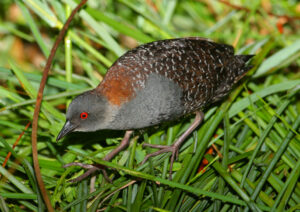
Black Rail Habitat. Photo by Woody Woodrow
Identifying Potential Sites for Habitat Creation
Using results from the Eastern Black Rail Species Distribution Model for (Stevens et al. in prep) the ACJV developed a buffering tool to identify priority areas to target habitat creation for Black Rails in the tidal zone. This buffering tool is still in development but a draft can be found here:(https://arcg.is/11nLmi). A similar buffering tool is in development for non-tidal areas in Florida and is expected to be available by DATE. These buffering tools can be used in tandem with the irrigation tool, described below, to identify specific wetland creation projects on the ground.
Competitive State Wildlife Grants (C-SWG):
Southeastern JV partners were awarded a $695,000 competitive State Wildlife Grant (C-SWG) in 2021 for Black Rail conservation. This grant, led by the Florida Fish and Wildlife Conservation Commission, will restore, enhance or create more than 1,100 acres of Black Rail habitat across four states (VA, NC, SC and FL). Funded projects include the creation of sheet flow wetlands and microtopography to improve Black Rail habitat, manage impoundments to support Black Rails, and implement prescribed burns as a means to manage and create new habitat. All project sites were chosen within habitat buffers identified by the Black Rail working group as having the greatest potential for attracting and supporting Black Rails.
Natural Resource Conservation Services (NRCS) Conservation Effects Assessment Project (CEAP):
The JV was awarded a second year of funding from NRCS through the CEAP program to support assessment and creation of Black Rail habitat in non-tidal lands. This project will begin to develop and test management techniques that can be applied to inland wetlands in southern Florida and develop management guidance for promising management actions that can be applied throughout the ACJV Black Rail range.
State Working Group and USFWS National Wildlife Refuge Meetings

Black Rail. Photo by Bob Gress
Two State Working Group meetings were held virtually for the North Carolina and Florida Black Rail Working Groups. Thirty-three attended the North Carolina meeting and 62 attended the Florida meeting. The focus of the workshops was to discuss developing habitat projects for Black Rail, share lessons learned from work already going on on the ground, and discuss survey protocols and use of Autonomous Recording Units (ARUs). One ongoing goal is to continue to develop projects that can be evaluated through the Adaptive Management Project, specifically those projects that address fire/herbicide to manage Black Rail habitat or apply water on the landscape to create new habitat. Additionally, the National Wildlife Refuge System held two meetings with Refuge staff and partners to address the same topics. One meeting was held in person at Alligator National Wildlife Refuge, with the primary purpose of identifying potential projects on the Refuge, which are now in progress. A similar meeting was held virtually for Refuges and partners in South Carolina and a follow up meeting with site visits is scheduled for early 2022. A meeting of Florida refuge staff and partners is also planned for early 2022.
